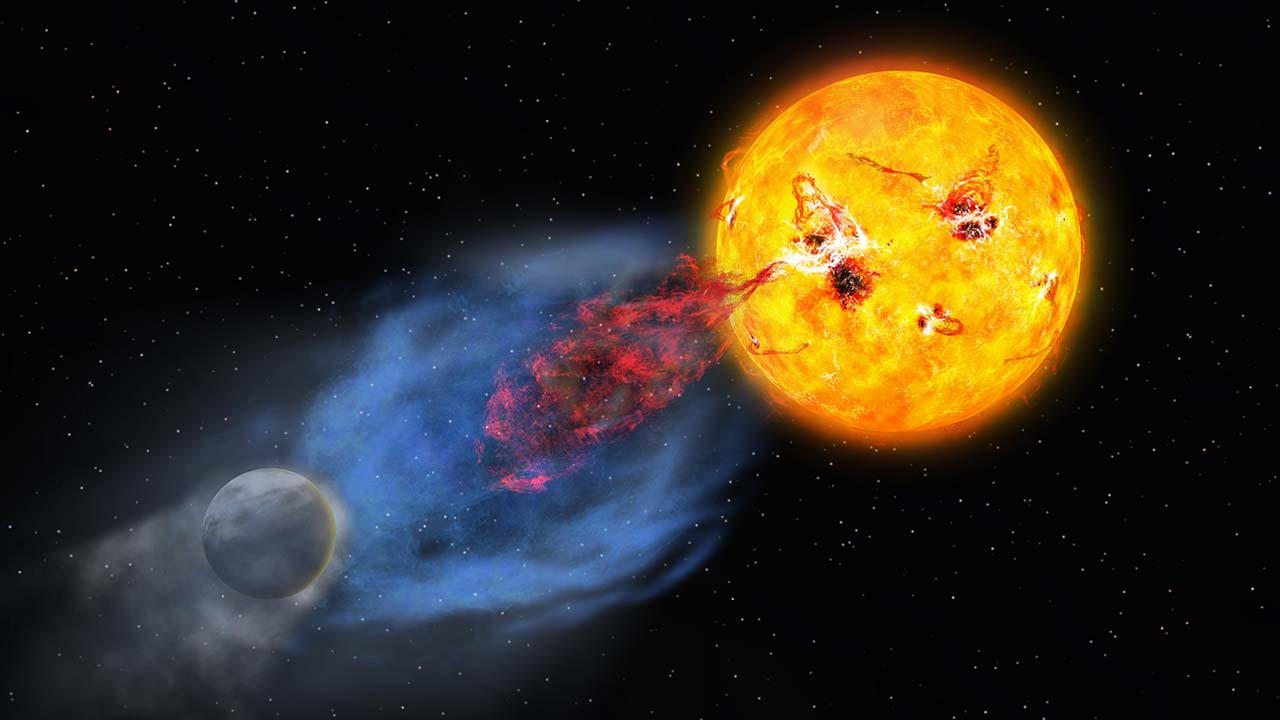
Astronomers have used simultaneous ground-based and space-based observations to measure the temperature and velocity of gas ejected from a young Sun-like star. The result showed a two-component ejection consisting of a hot fast component followed by a slower cooler component. This result is important for understanding how young stars affect their surrounding environment where planets and life may first be forming, and by extension provides insights into the early days of the Solar System, Earth, and life on Earth.
The Sun frequently ejects huge masses of hot ionized gas called plasma, associated with solar flares. These events are known as Coronal Mass Ejections (CMEs). Young Sun-like stars have been observed to emit frequent stellar flares, and some of them are known to be associated with large CMEs, dwarfing any observed from the modern Sun. CMEs on the Sun contain components at different temperatures, ranging from 10,000 Kelvin to 1,000,000 Kelvin, but so far data for CMEs on other stars have been limited to a single temperature component, especially low temperature plasma.
To get a more complete understanding of young stars' CME events, an international team of researchers led by Kosuke Namekata at Kyoto University arranged for ultraviolet observations by the Hubble Space Telescope, and optical observations by ground-based telescopes in Japan and Korea to simultaneously measure different temperature components of a stellar CME event. Their target was the young Sun-like Star EK Draconis, located 111 light-years away in the direction of the constellation Draco.
The team succeeded in observing different temperature components of a CME event. First, hot plasma of 100,000 Kelvin was ejected at 300 to 550 kilometers per second, followed about ten minutes later by a cooler gas of about 10,000 Kelvin ejected at 70 kilometers per second. This indicates that the hotter components of stellar CMEs possess higher kinetic energies than the cooler ones, and thus can affect exoplanetary atmospheres more severely than previously inferred from measurements limited to cool plasma alone.
Because the young Sun was presumably similar to EK Draconis, this provides insights in to the conditions in the early Solar System, which was likely disturbed by huge and fast CMEs. Theoretical and experimental studies suggest that fast CMEs play a role in initiating biomolecules and greenhouse gases, which are essential for the emergence and maintenance of life on an early planet. Therefore, this discovery has major implications for understanding planetary habitability and the conditions under which life emerged on Earth, and possibly elsewhere.
The team plans to continue their research with new observations using X-rays, radio waves, and next-generation UV space telescopes to better understand the conditions around young stars where planets, and possibly living things, form. In particular, this study highlights the importance of UV astronomy, which will be further explored by JAXA's upcoming LAPYUTA mission.
Release Information
Researcher(s) Involved in this Release
- Kosuke Namekata (Kyoto University/NASA Goddard Space Flight Center)
- Kazunari Shibata (Kyoto University/Doshisha University)
- Hiroyuki Maehara (NAOJ)
- Satoshi Honda (Nishi-Harima Astronomical Observatory, University of Hyogo)
- Yuta Notsu (University of Colorado Boulder)
- Kevin France (University of Colorado Boulder)
- Jongchul Chae (Seoul National University)
- Vladimir S. Airapetian (NASA Goddard Space Flight Center)
Coordinated Release Organization(s)
- Kyoto University
- National Institutes of Natural Sciences, National Astronomical Observatory of Japan
- Nishi-Harima Astronomical Observatory, University of Hyogo
- NASA Goddard Space Flight Center
- University of Colorado Boulder
- Seoul National University
Paper(s)
- Kosuke Namekata et al. "Discovery of multi-temperature coronal mass ejection signatures from a young solar analogue", in Nature Astronomy, DOI: 10.1038/s41550-025-02691-8
- Kosuke Namekata et al. "Do Young Suns Produce Frequent, Massive CMEs? Results from Five-Year Dedicated Optical Observations of EK Draconis and V889 Hercules", in The Astrophysical Journal, DOI: 10.3847/1538-4357/adfe70






